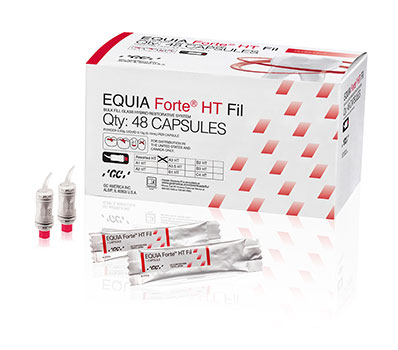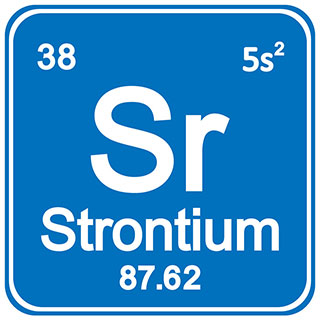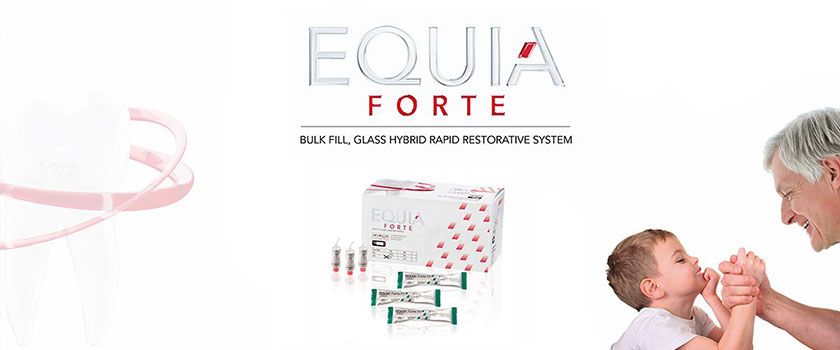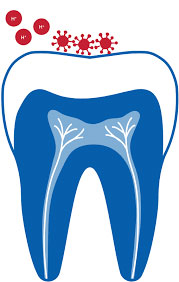The type of dental material used and the skill of the dentist makes a significant impact on the predictability of dental treatment.
St. Lawrence Dentistry uses several classes of filling materials during its efforts to serve the Mississauga Community. One of these is Glass Ionomers, which offers a unique set of beneficial and synergistic properties.
Glass restorative technology is ideal for minimally invasive dentistry. It can chemically fuse to the tooth without an additional bonding agent. Its intimate sealing properties are distinctly noticeable when viewing scanning electron micrographs around the margins of these restorations. On the contrary, dental composites (another filling material) show surprising gaps in these scans, which can eventually translate into visible brown lines around dental fillings.

Dr. Hawryluk Jr. loves the fact that glass ionomer fillings have a chemical fusion between the glass ionomer technology and the hydroxyapatite of tooth crystals. The chemical fusion allows an ionic interchange between the material and the tooth. With glass ionomer materials, there is no unnecessary cutting of the tooth, and it can protect against cavities because it has a fluoride-releasing property. They are great for use in children’s dentistry because their placement is possible in a more moist environment (compared to dental composites). Glass ionomers have an excellent bond to caries affected dentin (tooth dentin exposed to cavities). Comparatively, it is challenging to get a good bond to caries affected dentin with composites. In this scenario, enzymes demineralize the dentin and degrade the tooth’s collagen matrix this hinders the bonding of dental composites.

The disadvantages of glass ionomers are they do not have the strength, clarity, and aesthetics of dental composites. However, there are new highly aesthetic glass ionomers used by Dr. Hawryluk Jr., which have circumvented many of these deficiencies. These modern glass ionomers are called Equia Forte HT which are a strontium based glass ionomer. If we need even higher aesthetics, Dr. Hawryluk can use a sandwich technique where he bonds a composite veneer over top of the glass ionomer providing the perfect mix of function and aesthetics.

Dr. Hawryluk Jr. is a firm believer that strontium based glass ionomer material represents a huge leap forward in dental technology. Strontium can replace calcium and hydroxyapatite in a tooth. In the periodic table, it is the group 2A, which is right beneath calcium. Elements in the same group in the periodic table can exchange with each other. Hence, if a tooth is deficient in calcium, it can replace it with the strontium.

One key attribute about glass ionomers is a dynamic ion exchange which can recharge the tooth with ions. In comparison, these ions cannot move through dental composite material. Fluoride can keep teeth from decaying, and the kinetics of fluoride in glass ionomer is terrific. When fluoride concentration in the glass ionomer runs low, it can be recharged with more outside fluoride and have it move through the material to reach the tooth.

At St. Lawrence Dentistry, our goals are not only about providing effective cavity management therapy but also finding a protocol you will use. For example, Chlorhexidine mouth rinse is an effective treatment for gum issues and cavities, but it does not taste good and hence poses compliance problems. We will find that will and won’t work for you. Two preventative products that work in concert with glass ionomer restorations are Recaldent™ and Xylitol. Recaldent is the trademark name of a naturally occurring protein known as CPP-ACP (casein phosphopeptide-amorphous calcium phosphate). Recaldent provides a rich source of calcium and phosphate to aid in remineralization of tooth enamel. Xylitol can help stimulate saliva flow, and when this happens, the saliva’s ionic concentration goes up. You can dissolve a packet of xylitol powder in water and have them sip on that the whole day.

Dr. Hawryluk Jr. is a Mississauga Dentist committed to finding the best anti-cavity regime for you. Fixing cavities with glass ionomer technology takes advantage of its enormous beneficial properties. Also, Recaldent products such as MI paste can further enhance the protection of your teeth. If you are looking for a Mississauga Dentist, please call or stop by our office. We are located in the Port Credit district of Mississauga right by Lake Ontario. Our goal is to serve our community and offer exceptional service to our patients.
Reference: Brian Novy – Viva Learning 2/24/20
- St. Lawrence Dentistry Looks Forward To St. Patrick’s Day! - March 12, 2025
- Understanding Dental X-Rays and Radiation: What You Should Know - January 13, 2025
- Happy New Year from St. Lawrence Dentistry! - December 30, 2024










